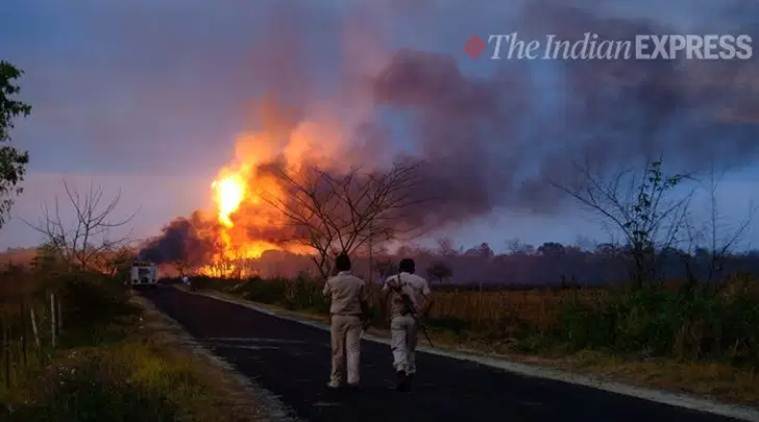- India
- International
Days before Assam fire, OIL cleared curbs to get nod for project inside national park
On May 11, OIL obtained environment clearance from the Centre for drilling seven wells inside Dibru Saikhowa using the sub-surface Extended Reach Drilling (ERD) technology from three existing wells (Baghjan 3, 5 and 11) adjacent to the park.
 Baghjan 5 well near Dibru-Saikhowa National Park caught fire 14 days after it had reported a blowout (Express Photo by Diganta Rajkhowa)
Baghjan 5 well near Dibru-Saikhowa National Park caught fire 14 days after it had reported a blowout (Express Photo by Diganta Rajkhowa)
DAYS BEFORE a blowout in its Baghjan oil field bordering the Dibru Saikhowa national park in Assam put “all life forms” in the vicinity at risk, Oil India Limited (OIL) obtained environment clearance for exploring and extracting gas from inside the park — despite restrictions in the mining lease on carrying out surveys inside sanctuaries and national parks.
On May 11, OIL obtained environment clearance from the Centre for drilling seven wells inside Dibru Saikhowa using the sub-surface Extended Reach Drilling (ERD) technology from three existing wells (Baghjan 3, 5 and 11) adjacent to the park.
According to OIL, the technology enables it to drill at a depth of 3,500-4,000 metres without disturbing the forest land surface. Unlike conventional drilling that breaks the land surface above the target, ERD reaches the necessary depth at a different location before moving horizontally to reach the target.
However, a state forest officer, who has served at Dibru Saikhowa, told The Indian Express: “Using ERD tech for the first time in India may sound like a futuristic solution for avoiding surface damage. But given our record on safety issues, imagine the impact of gas and oil spills from these wells right under a river channel that joins the Brahmaputra barely 20 km downstream.”
On May 26, Baghjan 5 erupted with gas and crude oil, and burst into flames 15 days later. The company has not been able to contain the leak or the blaze yet.

Read| Assam pollution control board tells OIL to shutter Baghjan ops
Meanwhile, the exploration and extraction project inside the park is awaiting forest clearance.
Asked if the park project violated mining lease conditions, OIL spokesperson Tridiv Hazarika said: “We were not doing or intended to do any activity on the forest surface. However, we are committed to fulfilling all legal requirements. That is why we have applied for forest clearance for the ERD wells although we will not enter the surface area of the forest land.”
Editorial| Inferno in Assam
Sanjay Kumar, Director General (Forests), Environment Ministry, said: “The forest clearance process is comprehensive and all relevant issues will be looked into, in view of the recent mishap.”
In 2006, the Assam government granted a 20-year (2003-2023) petroleum mining lease to OIL for Baghjan in Tinsukia district, “subject to strict observation” of 17 conditions. While OIL was free to carry out exploration surveys in reserve forests without cutting trees, the lease stipulated that “the lessee shall…in no circumstances carry out such surveys” inside wildlife sanctuaries and national parks.
In its submissions for environment and wildlife clearances during 2016-2017, OIL stated that there was no need for forest land or forest clearance since the seven wells would be drilled using the ERD technology without disturbing the surface.
Read | Assam gas leak and fire: Severe floods leads OIL to call off blowout ops for the day
This, the company claimed, would comply with the lease restriction. However, OIL had to apply for forest clearance in 2017 since the Forest Conservation Act, 1980 also covered “the entire underground mining area beneath the forest”.
Earlier, the Environment Ministry had exempted the “expansion project” from public hearing while Assam reduced the national park’s eco-sensitive zone (ESZ) to accommodate the Baghjan wells.
In December 2019, an Environment Appraisal Committee of the Ministry exempted the project from public hearing on the ground that the exercise was “practically impossible due to the vulnerability of the area”, which would cause “suspension of production activities”. It said that “every drop of oil production would significantly contribute towards meeting the PMO’s vision of reducing our oil import 10% by 2022”.
Read | Assam Gas Leak and Fire: NGT directs OIL to pay Rs 25 crore deposit in connection to Baghjan tragedy
But with public hearing mandatory under the Environment Impact Assessment Notification 2006, the Ministry issued an amendment this January, shifting all oil and gas exploration projects to the “B2” category that did not require public consultation.
Earlier, in 2018, Assam reduced the southern limits of the ESZ from 8.7 km to zero, due to the “existence of crude oil and natural gas in the immediate vicinity of the southern side of the National Park boundary”. The three existing wells that the OIL proposed to use for ERD are at a distance of 1.1-1.5 km from the national park boundary.
In 2016, OIL had petitioned the Supreme Court to modify its order prohibiting mining within 1 km of sanctuaries and national parks across India. The apex court referred the project to the National Board for Wildlife, which cleared it in 2017.
Read | Assam: After directing OIL to shutter Baghjan ops, pollution control board withdraws notice
A week after the May 26 blowout, in a preliminary report submitted to the Environment Ministry, the Wildlife Institute of India noted widespread damage caused to “all life forms”. It cautioned that “the approved new wells should be initiated only after a thorough investigation of potential impact, as well as evaluating disaster handling capabilities in place, with appropriate technology and trained manpower”.
OIL’s Hazarika said: “Right now our priority is to cap the Well on fire. If all necessary clearances come through, it will take another 18 months to start the extension work and drilling seven wells will take another four years or so.”
Apr 23: Latest News
- 01
- 02
- 03
- 04
- 05







































